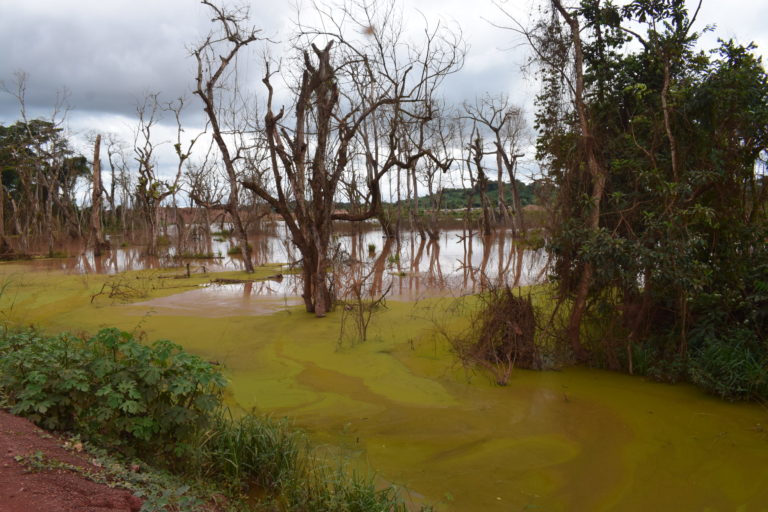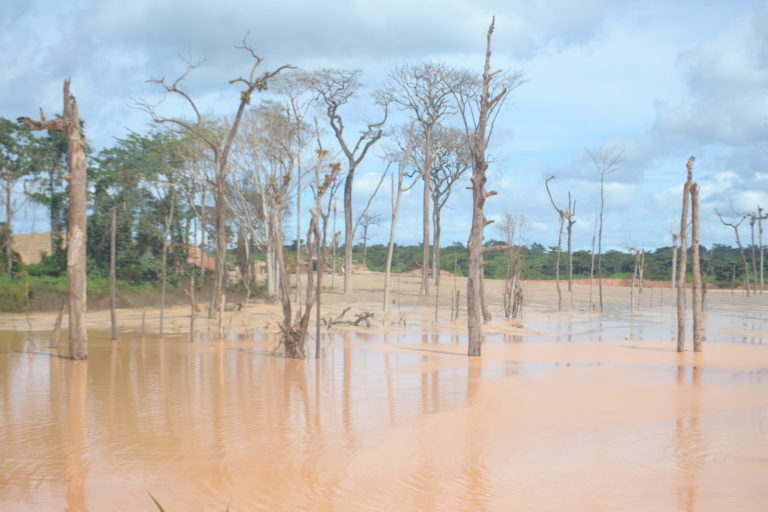Inactive mining sites in Cameroon are continuously abandoned without restoration by foreign companies, leaving behind huge pits in the ground that later form into artificial lakes which endanger local populations and damage ecosystems.In January, a 13-year-old boy drowned in one of these lakes near Yaoundé, left behind by the quarry company Transatlantique Cameroon Ltd, a subsidiary of the Chinese consortium Cameroon Meilan Construction Conglomerate (CMCC).In 2021 and 2022, the Cameroonian NGO Forests and Rural Development (FODER) identified more than 700 mining pits in Cameroon, including 139 which had become artificial lakes, claiming the lives of more than 200 people.Cameroonian legislation obligates mining companies to refill mining pits after their operations. Despite this, the law is not being adhered to or enforced.
YAOUNDÉ, Cameroon – A ruined mining site rests at the heart of the village of Akak I, nestled on the outskirts of Cameroon’s capital Yaoundé. This quarry site is no longer active. After being completely mined by Transatlantique Cameroon Ltd, a subsidiary of the Chinese consortium Cameroon Meilan Construction Conglomerate (CMCC), it was abandoned. All that remains is a giant pit in a scarred landscape, covering an area of nearly four hectares (nearly 10 acres).
Inside this pit, an artificial lake has formed from accumulated rainfall, becoming a safety hazard for the local community. At the end of January, a 13-year-old boy named Fabrice drowned there while swimming with friends. This is the first tragedy to occur at this site since the company ceased operations in 2021, and has shaken the local residents.
An overview of the artificial lake left behind by the company Transatlantique Cameroon Ltd, where 13-year-old Fabrice drowned on January 28, 2023 in Akak I. Image by Yannick Kenné. The abandoned mining site left behind by Transatlantique Cameroon Ltd in Akak I. Image by Yannick Kenné.
The abandoned mining site left behind by Transatlantique Cameroon Ltd in Akak I. Image by Yannick Kenné.
However, there have been several other reported cases of drownings in similar artificial lakes in recent years. According to a census carried out by the NGO FODER (Forests and Rural Development) between 2015 and 2022, 205 deaths were recorded at mining sites in the East and Adamaoua regions between 2015 and 2022, including 12 cases of drowning in artificial lakes. The other 193 deaths were caused by cave-ins and landslides triggered by the abandoned pits.
Most of the time, these pits are abandoned by foreign mining companies after their operations. The mining companies are based in India, Greece, Cameroon, and most commonly China.
In September 2021, FODER recorded 703 pits at mining sites, including 139 artificial lakes over an area of 93.66 hectares (about 230 acres). Companies have also dumped waste oils and hydrocarbons in these areas, polluting the region.
“Of all the deaths recorded at abandoned mining sites, the most striking is that of Samba. In 2017, the 12-year-old was walking home when he slipped into a deep pit abandoned by Metallicon S.A and died. His family came to us for legal support. Two lawsuits were filed, one in Bertoua and one in Batouri. We won the Batouri case, but unfortunately, when the time came to enforce the court decision, we couldn’t reach the company,” says FODER executive Justin Landry Chekoua.
 A pit at the abandoned mining site where Chinese company Transatlantique dumped its hydrocarbon waste. Image by Yannick Kenné.
A pit at the abandoned mining site where Chinese company Transatlantique dumped its hydrocarbon waste. Image by Yannick Kenné.
In a 2022 report on semi-mechanized mining in Cameroon, the Cameroonian organization the Centre for Environment and Development (CED) found that mining contributes to the destruction of forest cover (gold mining being particularly damaging) and leaves behind hundreds of hectares of degraded land. The abandonment of such sites stalls restoration efforts to recover ecosystems damaged by mining.
For environmentalist Émile Temgoua, a professor at the University of Dschang, “this causes a massive loss of biodiversity. When you look at the land, you’ll see that all the savannah, forest, wild animals… are gone. We have lost all these spaces and species,” he says.
Between 2020 and 2021, the CED also found that Chinese mining companies dumped mercury and toxic products in Kadéï River, Eastern Cameroon, which caused the death of three hippopotami (Hippopotamus amphibius). The hippopotamus population in Eastern Cameroon is in sharp decline and in endanger of becoming extinct. Today, about 20 remain compared to over 100 ten years ago. Two years ago, a hippopotamus was rescued from an abandoned gold mining pit.
Read more: Chinese companies criticized for mercury pollution in Cameroon
Mining regulation in limbo
In Cameroon, national mining legislation is still in development. Still, environmental regulations on mining companies exist. However, many regions operate under a status quo where these regulation are not strictly enforced by local authorities. A regulation currently requires mining sites and pits to be closed up and restored after operations. A similar situation presents itself in the Democratic Republic of Congo (DRC), where the government and local authorities do not stricly enforce regulations in the mining sector—and importantly, requirements to restore abandoned mining sites.
 An artificial lake in Kambelé III, resulting from an abandoned mining pit, polluted by waste oils and hydrocarbon products dumped by mining companies. Image by Yannick Kenné.
An artificial lake in Kambelé III, resulting from an abandoned mining pit, polluted by waste oils and hydrocarbon products dumped by mining companies. Image by Yannick Kenné.
Cameroon adopted a new Mining Code in 2016, which specifies in article 136 that “the restoration, rehabilitation, and closure of mining sites and quarries are the responsibility of each operator.” However, this provision is largely ignored, as it requires the President Paul Biya to sign off on this law, which has been delayed for six years.
Consequently, mining activity in Cameroon is still governed by the old Mining Code containing multiple loopholes adopted in 2001, as well as a host of decrees, the last of which was signed on July 4, 2014.
The question of the Cameroonian Mining Code is one which the Cameroonian ministry of mines, which was contacted by Mongabay, did not explicitly address, explaining that “there is still a series of specific legislation that can only be approved by the President, not the ministry.”
However, the Cameroonian ministry of mines says it understands the danger represented by the semi-mechanization gold mining, and from March 31, 2023, will no longer issue artisanal mining licenses to foreign companies, so they become an exclusive privilege of artisanal miners as provided for in the suspended mining code. This will ensure better regulations for gold mining, which is a leading cause of extractive-related disasters in Cameroon.
 The Mbil River drying up due to a Chinese company’s mining operations located upstream. Image by Yannick Kenné.
The Mbil River drying up due to a Chinese company’s mining operations located upstream. Image by Yannick Kenné.
In 2022, Yakouba Djadaï, the mayor of the village of Kambelé III in Eastern Cameroon, decided to suspend all mining businesses after it recorded several deaths at mining sites and the devastating effects on its biodiversity. A total of nine companies were affected by this decision, including six based in China. Following this decision, the region has launched a reforestation operation on this site after filling the pits.
The proliferation of mining pits has also led a group of young people from the mining town of Bétaré Oya to launch a campaign in 2022 to fill abandoned pits, with the aim of eventually restoring more than 700 pits in an attempt to make their communities safer.
However, despite these municipal and grassroots initiatives, local communities hope government action and stricter enforcement will do more to prevent companies from leaving huge pits in the wake of their abandoned sites in the first place.
Back in Akak I, Rodrigue Afane, a local whose family lives near the abandoned mine, still fears for the safety of his children: “This pit represents a real danger for people living nearby. At any time, a child can end up falling in and drowning like Fabrice.”
This article was first published here on Mongabay’s French site.
Banner image: A mining pit transformed into an artificial lake. Image © Yannick Kenné
Related listening from Mongabay’s podcast: A conversation with Anuradha Mittal, executive director of the Oakland Institute, and Christian-Geraud Neema Byamungu, a Congolese researcher, about how resource extraction is impacting human rights and the environment in the Democratic Republic of Congo. Listen here:
Tense neighbors: Chinese quarry in Cameroon takes a toll on locals
FEEDBACK: Use this form to send a message to the author of this post. If you want to post a public comment, you can do that at the bottom of the page.
Conservation, Ecological Restoration, Ecosystem Restoration, Environmental Law, Gold Mining, Landscape Restoration, Law, Law Enforcement, Mining, Pollution, Restoration
Africa, Cameroon, West Africa
Source link : https://news.mongabay.com/2023/02/treacherous-pits-and-lakes-left-in-the-wake-of-cameroons-abandoned-mining-sites/
Author :
Publish date : 2023-02-24 08:00:00
Copyright for syndicated content belongs to the linked Source.





